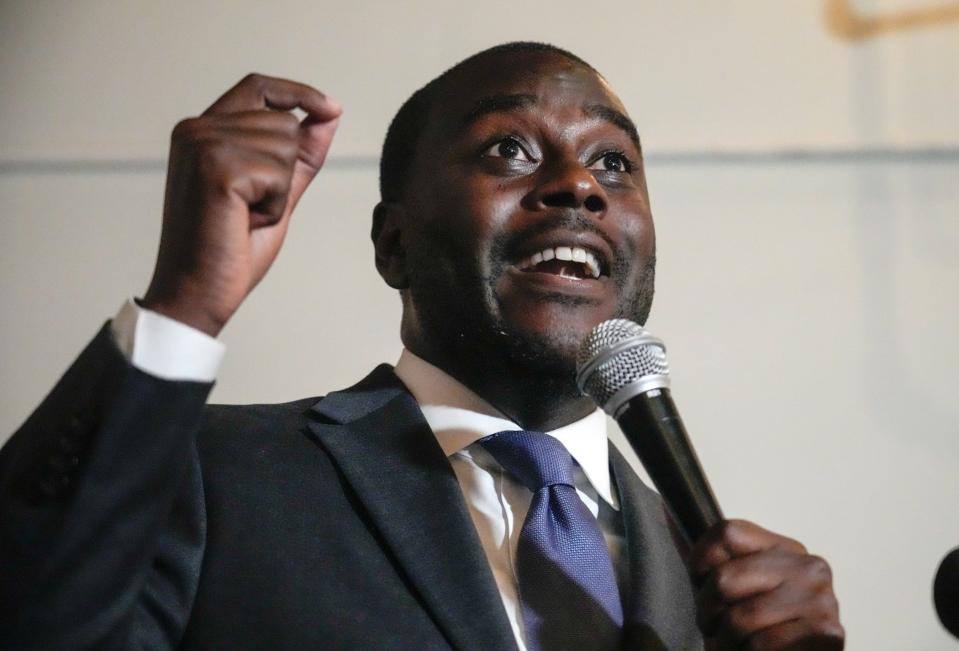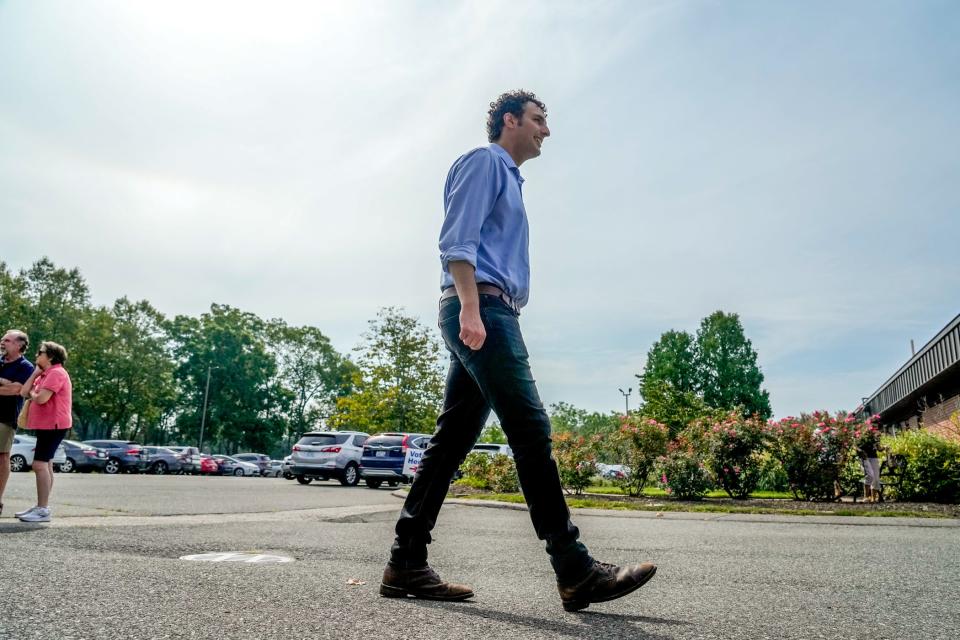How Gabe Amo won, and what it could mean for future campaigns in RI
- Oops!Something went wrong.Please try again later.
- Oops!Something went wrong.Please try again later.
- Oops!Something went wrong.Please try again later.
- Oops!Something went wrong.Please try again later.
For the second year running, Rhode Island voters Tuesday delivered a shock in a nationally watched congressional race.
Gabe Amo's Democratic primary win over a turbulent, 11-candidate 1st District special election field, less than a year after Seth Magaziner's 2nd District win over Republican Allan Fung, was another big victory for a mainstream, establishment Democrat.
In both races, the margin of victory was surprising even if you weren't caught off guard by who won. Amo on Tuesday carried all but three 1st District communities – Providence, Woonsocket and Central Falls – and won by 3,000 votes when many thought it would be a nail-biter.
Amo's internal polling suggested he was firmly in second place as recently as three weeks ago.
On the campaign trail, Amo emphasized his humble roots – his father owns a liquor store and his mother is a nurse – as well as his high-level experience working in the Obama and Biden administrations, and for former Gov. Gina Raimondo.
If he goes on to win the general election as expected, Amo will be the first person of color elected to represent Rhode Island in Congress.
After months of speculation about what might happen when a rare open Rhode Island House seat became available, here are a few takeaways on why it happened and what it means.

The left was divided, not the center
Conventional wisdom suggested a crowded field with several establishment candidates would divide the moderate vote and open a pathway for the progressive Aaron Regunberg.But controversy consumed two rival moderate campaigns – Sabina Matos and Donald Carlson – and the results show their voters flocked to Amo more than anyone could see or realize without independent polling.At the same time, endorsements by Bernie Sanders and Alexandria Ocasio-Cortez failed to unite the left, where a vocal anti-Regunberg constituency blunted his message and some progressive support was siphoned off to Sandra Cano and Ana Quezada.
Regunberg may also have misjudged the impact those last-lap endorsements from Bernie and AOC had on comparatively moderate Rhode Island Democrats fearful of what extreme measures to squash "Big Oil" and other corporate boogeymen would do to the prices they pay for electricity and other essentials.Meanwhile, organized labor in Rhode Island remains firmly divided and often hostile to progressive candidates.
The Joe Biden brand may poll poorly, but in blue states it sells
That's how a former aide to Biden wins running "The West Wing" ads with gauzy images of the candidate, president and the Oval Office. Adding in Barack Obama, whom Amo also worked for and from whom he has adopted some stylistic traits, plus a Kennedy endorsement, and you end up with a potent combination.Biden's first term has been a difficult environment for both progressive and GOP challengers compared to the Obama and Trump years, moving left on policy but conventional in tone, creating a comfortable, safe space for "normie" Democrats.

The power of television and staying out of controversy
Amo raised enough money to lift his initially low name recognition and stay on the air throughout August without having to lean too heavily on outside groups.
Providence College Political Science Prof. Adam Myers said Amo's ads were well placed to attract voters seeking an alternative to Matos when her campaign was investigated for fake nominating signatures."His TV spots emphasized his ties to Democratic standard-bearers like Obama and Biden, and he largely espoused mainstream Democratic positions in the debates," Myers wrote in an email. "He also ran an excellent ground game in concert with very effective TV advertising."The identification of Matos and Regunberg as early frontrunners gave Amo the opportunity to stay under the radar and out of negative exchanges until the end.
"The breadth of Amo’s victory was rather remarkable," Myers added. "He dominated in upscale, majority-white communities like Barrington, while also winning in more downscale, racially diverse communities like Pawtucket and East Providence."Brown University Political Science Professor Wendy Schiller's takeaway: "Amo had a district-wide strategy and did not focus exclusively on one geographic area or democratic constituency. [He] avoided scandals and active negative engagement with the other frontrunner candidates ... He used his TV ad buys wisely, emphasizing his local roots and his solid Democratic credentials. Amo [also] came off as sincere and likeable, and managed to stay above the frontrunner fray. He carved out a victory lane without using political knives."
Who else came out of primary day a winner?
Cano, whose third-place finish on a shoestring budget raised her political profile outside of Pawtucket.
Mindy Myers, the Amo campaign's lead strategist and head of his TV operation, plus the rest of the campaign team led by manager Lauren Garrett.
The Congressional Black Caucus, Democrats Serve and Collective PAC, three national groups that backed Amo. The Collective PAC is run by former Rhode Island Democratic Party executive director Tolulope Kevin Olasanoye.
And who came out of primary day in a worse position?
Matos, who went from an apparent frontrunner with statewide name recognition, fresh off a 2022 win, to fourth place after enduring weeks of reputational hits over the signature probe and a botched rollout of endorsements by people who, in some cases, denied having endorsed her. Not only that, her relationship with Gov. Dan McKee, who did not endorse her after hand-picking her to be lieutenant governor, appears severely strained.
Emily's List and the Congressional Hispanic Caucus, which put major money behind Matos.
Bernie Sanders, whose own popularity did not, for the second Rhode Island election cycle in a row, translate into success for candidates he endorses.
The press. Agree with him or not, Regunberg would have spiced up a Rhode Island congressional delegation that rarely gets into policy disagreements and whose members at times seem like they could finish each other's news releases. Even if he would have been on his best behavior in his first year, Regunberg would have brought a different perspective and potentially more drama.
Divided support for the Latina candidates
Lt. Gov. Sabina Matos and state Senators Sandra Cano and Ana Quezada each had to compete for support and money from D.C. groups that support progressive women, and Latino candidates especially. Matos' backers steered more than $800,000 into ads and mailers. Between them, the three women split more than 9,600 votes.
What went wrong for Regunberg?
Lots of things. He was attacked in the final debate for being a privileged white man. That, he could not change. But the decision not to upend the dinner table and demand his family not fund a Super PAC supporting him turned out to be a self-inflicted wound.

Beyond that, his messaging leaned heavily on the somewhat abstract concept of fighting "corporate interests," rather than something more tangible or positive. Whatever its merits as policy, it didn't seem to resonate with voters and sometimes sounded focus-grouped.
What might have been for Helena Foulkes
The Amo narrative can read like an alternative history of Foulkes' near-miss run for governor last year: A centrist Democrat with Gina Raimondo ties, but low name recognition, runs a well-funded, television-heavy campaign that only starts mixing it up with rivals late in the summer.The Foulkes campaign was criticized for waiting too long to draw contrasts with opponents or generate attention, but in some ways the Amo strategy provides proof of concept. A big difference between the two campaigns: Amo released that internal poll two weeks before the primary, showing him gaining ground and making it look like a two-person race with Regunberg. Foulkes did not release any internal polling.
What next?
Schiller: "I am most interested in two things: One is how does Gabe Amo solidify his position to avoid a contested primary next year?"
"Two," Schiller continued, "Is whether he succeeds in capturing the attention and support of the House Democratic Party leadership in terms of committee assignments and national fundraising assistance."
This article originally appeared on The Providence Journal: RI congressional special election primary: Top takeaways from Amo's win

